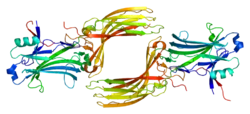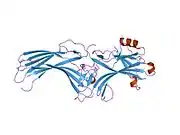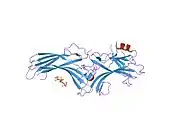Arrestin, beta 1, also known as ARRB1, is a protein which in humans is encoded by the ARRB1 gene.[5][6]
Function
Members of arrestin/beta-arrestin protein family are thought to participate in agonist-mediated desensitization of G protein-coupled receptors and cause specific dampening of cellular responses to stimuli such as hormones, neurotransmitters, or sensory signals. Arrestin beta 1 is a cytosolic protein and acts as a cofactor in the beta-adrenergic receptor kinase (BARK) mediated desensitization of beta-adrenergic receptors. Besides the central nervous system, it is expressed at high levels in peripheral blood leukocytes, and thus the BARK/beta-arrestin system is believed to play a major role in regulating receptor-mediated immune functions. Alternatively spliced transcripts encoding different isoforms of arrestin beta 1 have been described, however, their exact functions are not known.[6] Beta-arrestin has been shown to play a role as a scaffold that binds intermediates and may direct G-protein signaling by connecting receptors to clathrin-mediated endocytosis.[7]
Interactions
Arrestin beta 1 has been shown to interact with
References
- 1 2 3 GRCh38: Ensembl release 89: ENSG00000137486 - Ensembl, May 2017
- 1 2 3 GRCm38: Ensembl release 89: ENSMUSG00000018909 - Ensembl, May 2017
- ↑ "Human PubMed Reference:". National Center for Biotechnology Information, U.S. National Library of Medicine.
- ↑ "Mouse PubMed Reference:". National Center for Biotechnology Information, U.S. National Library of Medicine.
- ↑ Parruti G, Peracchia F, Sallese M, Ambrosini G, Masini M, Rotilio D, De Blasi A (May 1993). "Molecular analysis of human beta-arrestin-1: cloning, tissue distribution, and regulation of expression. Identification of two isoforms generated by alternative splicing". The Journal of Biological Chemistry. 268 (13): 9753–9761. doi:10.1016/S0021-9258(18)98412-7. PMID 8486659.
- 1 2 "Entrez Gene: ARRB1 arrestin, beta 1".
- ↑ Peterson YK, Luttrell LM (July 2017). "The Diverse Roles of Arrestin Scaffolds in G Protein-Coupled Receptor Signaling". Pharmacological Reviews. 69 (3): 256–297. doi:10.1124/pr.116.013367. PMC 5482185. PMID 28626043.
- 1 2 Claing A, Chen W, Miller WE, Vitale N, Moss J, Premont RT, Lefkowitz RJ (November 2001). "beta-Arrestin-mediated ADP-ribosylation factor 6 activation and beta 2-adrenergic receptor endocytosis". The Journal of Biological Chemistry. 276 (45): 42509–42513. doi:10.1074/jbc.M108399200. PMID 11533043.
- ↑ Conlan LA, Martin TJ, Gillespie MT (September 2002). "The COOH-terminus of parathyroid hormone-related protein (PTHrP) interacts with beta-arrestin 1B". FEBS Letters. 527 (1–3): 71–75. doi:10.1016/S0014-5793(02)03164-2. PMID 12220636. S2CID 83640616.
- ↑ Chen W, Hu LA, Semenov MV, Yanagawa S, Kikuchi A, Lefkowitz RJ, Miller WE (December 2001). "beta-Arrestin1 modulates lymphoid enhancer factor transcriptional activity through interaction with phosphorylated dishevelled proteins". Proceedings of the National Academy of Sciences of the United States of America. 98 (26): 14889–14894. Bibcode:2001PNAS...9814889C. doi:10.1073/pnas.211572798. PMC 64954. PMID 11742073.
- ↑ Wang P, Wu Y, Ge X, Ma L, Pei G (March 2003). "Subcellular localization of beta-arrestins is determined by their intact N domain and the nuclear export signal at the C terminus". The Journal of Biological Chemistry. 278 (13): 11648–11653. doi:10.1074/jbc.M208109200. PMID 12538596.
- ↑ Shenoy SK, Xiao K, Venkataramanan V, Snyder PM, Freedman NJ, Weissman AM (August 2008). "Nedd4 mediates agonist-dependent ubiquitination, lysosomal targeting, and degradation of the beta2-adrenergic receptor". The Journal of Biological Chemistry. 283 (32): 22166–22176. doi:10.1074/jbc.M709668200. PMC 2494938. PMID 18544533.
- ↑ Cen B, Yu Q, Guo J, Wu Y, Ling K, Cheng Z, et al. (March 2001). "Direct binding of beta-arrestins to two distinct intracellular domains of the delta opioid receptor". Journal of Neurochemistry. 76 (6): 1887–1894. doi:10.1046/j.1471-4159.2001.00204.x. PMID 11259507. S2CID 83485138.
- ↑ Bhattacharya M, Anborgh PH, Babwah AV, Dale LB, Dobransky T, Benovic JL, et al. (August 2002). "Beta-arrestins regulate a Ral-GDS Ral effector pathway that mediates cytoskeletal reorganization". Nature Cell Biology. 4 (8): 547–555. doi:10.1038/ncb821. PMID 12105416. S2CID 20784208.
Further reading
- Lefkowitz RJ (July 1998). "G protein-coupled receptors. III. New roles for receptor kinases and beta-arrestins in receptor signaling and desensitization". The Journal of Biological Chemistry. 273 (30): 18677–18680. doi:10.1074/jbc.273.30.18677. PMID 9668034.
- Lohse MJ, Benovic JL, Codina J, Caron MG, Lefkowitz RJ (June 1990). "beta-Arrestin: a protein that regulates beta-adrenergic receptor function". Science. 248 (4962): 1547–1550. Bibcode:1990Sci...248.1547L. doi:10.1126/science.2163110. PMID 2163110.
- Calabrese G, Sallese M, Stornaiuolo A, Morizio E, Palka G, De Blasi A (November 1994). "Assignment of the beta-arrestin 1 gene (ARRB1) to human chromosome 11q13". Genomics. 24 (1): 169–171. doi:10.1006/geno.1994.1594. PMID 7896272.
- Parruti G, Peracchia F, Sallese M, Ambrosini G, Masini M, Rotilio D, De Blasi A (May 1993). "Molecular analysis of human beta-arrestin-1: cloning, tissue distribution, and regulation of expression. Identification of two isoforms generated by alternative splicing". The Journal of Biological Chemistry. 268 (13): 9753–9761. doi:10.1016/S0021-9258(18)98412-7. PMID 8486659.
- Iacovelli L, Franchetti R, Masini M, De Blasi A (September 1996). "GRK2 and beta-arrestin 1 as negative regulators of thyrotropin receptor-stimulated response". Molecular Endocrinology. 10 (9): 1138–1146. doi:10.1210/mend.10.9.8885248. PMID 8885248.
- Bonaldo MF, Lennon G, Soares MB (September 1996). "Normalization and subtraction: two approaches to facilitate gene discovery". Genome Research. 6 (9): 791–806. doi:10.1101/gr.6.9.791. PMID 8889548.
- Goodman OB, Krupnick JG, Gurevich VV, Benovic JL, Keen JH (June 1997). "Arrestin/clathrin interaction. Localization of the arrestin binding locus to the clathrin terminal domain". The Journal of Biological Chemistry. 272 (23): 15017–15022. doi:10.1074/jbc.272.23.15017. PMID 9169477.
- Lin FT, Krueger KM, Kendall HE, Daaka Y, Fredericks ZL, Pitcher JA, Lefkowitz RJ (December 1997). "Clathrin-mediated endocytosis of the beta-adrenergic receptor is regulated by phosphorylation/dephosphorylation of beta-arrestin1". The Journal of Biological Chemistry. 272 (49): 31051–31057. doi:10.1074/jbc.272.49.31051. PMID 9388255.
- Aragay AM, Mellado M, Frade JM, Martin AM, Jimenez-Sainz MC, Martinez-A C, Mayor F (March 1998). "Monocyte chemoattractant protein-1-induced CCR2B receptor desensitization mediated by the G protein-coupled receptor kinase 2". Proceedings of the National Academy of Sciences of the United States of America. 95 (6): 2985–2990. Bibcode:1998PNAS...95.2985A. doi:10.1073/pnas.95.6.2985. PMC 19681. PMID 9501202.
- ter Haar E, Musacchio A, Harrison SC, Kirchhausen T (November 1998). "Atomic structure of clathrin: a beta propeller terminal domain joins an alpha zigzag linker". Cell. 95 (4): 563–573. doi:10.1016/S0092-8674(00)81623-2. PMC 4428171. PMID 9827808.
- Luttrell LM, Ferguson SS, Daaka Y, Miller WE, Maudsley S, Della Rocca GJ, et al. (January 1999). "Beta-arrestin-dependent formation of beta2 adrenergic receptor-Src protein kinase complexes". Science. 283 (5402): 655–661. doi:10.1126/science.283.5402.655. PMID 9924018.
- McDonald PH, Cote NL, Lin FT, Premont RT, Pitcher JA, Lefkowitz RJ (April 1999). "Identification of NSF as a beta-arrestin1-binding protein. Implications for beta2-adrenergic receptor regulation". The Journal of Biological Chemistry. 274 (16): 10677–10680. doi:10.1074/jbc.274.16.10677. PMID 10196135.
- Lin FT, Miller WE, Luttrell LM, Lefkowitz RJ (June 1999). "Feedback regulation of beta-arrestin1 function by extracellular signal-regulated kinases". The Journal of Biological Chemistry. 274 (23): 15971–15974. doi:10.1074/jbc.274.23.15971. PMID 10347142.
- McConalogue K, Déry O, Lovett M, Wong H, Walsh JH, Grady EF, Bunnett NW (June 1999). "Substance P-induced trafficking of beta-arrestins. The role of beta-arrestins in endocytosis of the neurokinin-1 receptor". The Journal of Biological Chemistry. 274 (23): 16257–16268. doi:10.1074/jbc.274.23.16257. PMID 10347182.
- Miller WE, Maudsley S, Ahn S, Khan KD, Luttrell LM, Lefkowitz RJ (April 2000). "beta-arrestin1 interacts with the catalytic domain of the tyrosine kinase c-SRC. Role of beta-arrestin1-dependent targeting of c-SRC in receptor endocytosis". The Journal of Biological Chemistry. 275 (15): 11312–11319. doi:10.1074/jbc.275.15.11312. PMID 10753943.
- Laporte SA, Oakley RH, Holt JA, Barak LS, Caron MG (July 2000). "The interaction of beta-arrestin with the AP-2 adaptor is required for the clustering of beta 2-adrenergic receptor into clathrin-coated pits". The Journal of Biological Chemistry. 275 (30): 23120–23126. doi:10.1074/jbc.M002581200. PMID 10770944.
- Bennett TA, Maestas DC, Prossnitz ER (August 2000). "Arrestin binding to the G protein-coupled N-formyl peptide receptor is regulated by the conserved "DRY" sequence". The Journal of Biological Chemistry. 275 (32): 24590–24594. doi:10.1074/jbc.C000314200. PMID 10823817.
- Shiina T, Kawasaki A, Nagao T, Kurose H (September 2000). "Interaction with beta-arrestin determines the difference in internalization behavor between beta1- and beta2-adrenergic receptors". The Journal of Biological Chemistry. 275 (37): 29082–29090. doi:10.1074/jbc.M909757199. PMID 10862778.
- Barlic J, Andrews JD, Kelvin AA, Bosinger SE, DeVries ME, Xu L, et al. (September 2000). "Regulation of tyrosine kinase activation and granule release through beta-arrestin by CXCRI". Nature Immunology. 1 (3): 227–233. doi:10.1038/79767. PMID 10973280. S2CID 6151896.
- Shukla AK, Westfield GH, Xiao K, Reis RI, Huang LY, Tripathi-Shukla P, et al. (August 2014). "Visualization of arrestin recruitment by a G-protein-coupled receptor". Nature. 512 (7513): 218–222. Bibcode:2014Natur.512..218S. doi:10.1038/nature13430. PMC 4134437. PMID 25043026.
External links
- Human ARRB1 genome location and ARRB1 gene details page in the UCSC Genome Browser.









